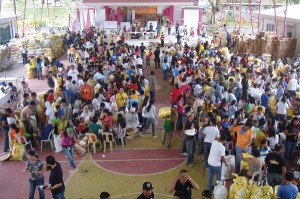
VOLUNTEERS and local government workers work 24 hours repacking relief goods at the provincial gymnasium in Mati City, Davao Oriental. FILE PHOTO
MANILA, Philippines–Nearly one million people remain in need of food assistance while relief organizations grapple to provide shelter to thousands amid funding gaps a month after a powerful typhoon swept through provinces rarely hit by storms in Mindanao.
The United Nations Office for the Coordination of Humanitarian Affairs (Unocha) made the assessment in a situation report released on Thursday, which assessed local and international humanitarian response in provinces hit by Typhoon “Pablo” in early December.
The UN agency reported that only 21 percent, or roughly a fifth of the UN’s initial appeal for $65 million in aid for Pablo victims, has been filled with $13 million in total international donations and up to $7 million in pledges.
“Between 800,000 and one million people are in need of food assistance in the worst affected areas,” said Unocha in the report.
Of this number, some 238,000 persons have received family food packs in the severely affected provinces of Compostela Valley, Davao Oriental, Surigao del Sur and Agusan del Sur, the UN agency said, citing data from the World Food Program and the Philippines’ Department of Social Welfare and Development.
School feeding programs are also set to be launched in public schools in severely hit areas through the Department of Education, said Unocha.
The report said agencies involved in providing shelter for displaced families were facing challenges in pursuing their programs.
“Agencies report severe funding constraints and are unable to expand their programs,” said Unocha.
The accurate number of affected homes also “remain difficult to ascertain” given conflicting reports from the field, said the UN agency.
This as displaced families face “poor living conditions, including congestion, lack of safe communal areas, lack of electricity and protection concerns,” the agency said.
Unocha further warned that families that lost their homes were facing secondary displacement as classes have resumed in schools being used as evacuation centers.
“There is a need to build and identify alternative displacement sites for families who are living in public schools,” said the agency.
Unocha also cited the “unequal humanitarian response” to affected families in the Caraga region in northeastern Mindanao, which was earlier attributed to difficulties in distribution.
So far, 1,067 persons were killed and 834 remained missing after Pablo hit provinces in Mindanao that rarely saw typhoons in the past. Citing data from Philippine agencies, Unocha said the typhoon affected 6.2 million people, with 13,490 still in evacuation centers while close to one million were forced to stay outside temporary shelters.